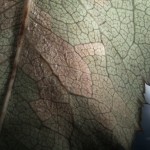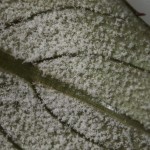What is it? What to do about it? ♣ Download fact-sheet pdf
Downy Mildews
by Elizabeth H. Roche, Nancy J. Taylor & Francesca Peduto Hand
Introduction
Downy Mildews are some of the most destructive diseases of ornamental crops. Contrary to Powdery Mildews, which are caused by true Fungi, downy mildews are caused by a distinct group of organisms called Oomycetes. Members of this group of pathogens also include water molds such as Pythium and Phytophthora species. Most of the downy mildew pathogens are host specific being able to infect only one plant family. Pathogen species include Peronospora, Bremia, Plasmopara and Basidiophora. They infect a wide variety of greenhouse crops including pansy, snapdragon, salvia, primula, verbena as well as cut flowers, including scabiosa and stock. In recent years, new destructive downy mildews have been reported on coleus and garden impatiens.
Identification
Downy mildew symptoms can greatly vary depending on the host where they develop. Early symptoms are often subtle and may pass unobserved. Small chlorotic spots on the upper side of leaves eventually enlarge to more extensive lesions of variable color (bronze to brown), often angular in shape because delimited by veins. As the disease progresses, lesions enlarge and leaves drop. Severe infections can also lead to plant death. Beneath the upper leaf lesions, a white to gray fuzzy growth will occur when high relative humidity conditions are met. Some downy mildew symptoms can be confused with those of powdery mildew, a common fungal disease of ornamental crops. Although the names are similar and both pathogens produce white-gray sporulation on infected leaves, downy mildew sporulation is only found on the underside of the leaf, while powdery mildew sporulation primarily develops on the upper side of the leaf.
For assistance in identification, contact the C. Wayne Ellett Plant and Pest Diagnostic Clinic.
Pathogen Biology
Downy mildew pathogens are biotroph organisms or obligate parasites, meaning that they require a living host tissue to grow and reproduce. These pathogens reproduce through structures called sporangia that form on the underside of infected leaves. After they are dislodged from diseased leaves by air currents or splashing water, they land onto healthy plants and initiate new infections. Moisture prompts the sporangia to release zoospores, which are able to swim through free moisture on the leaf surface due to the presence of motile appendages called flagella. Zoospores swim toward the leaf stomata, which then they penetrate to infect the host cells. Some downy mildews produce long lasting survival spores, called oospores, which can persist in the soil for many years and serve as source of inoculum for new plants.
Favorable Environmental Conditions
- Cool temperatures (58-72ºF, 15-23ºC)
- Relative humidity above 85%
- Long periods of leaf wetness
Management Guidelines
Downy mildews are very difficult to control once established so every effort should be made to prevent the disease and its introduction into the greenhouse. Always purchase disease free plants from reputable sources. Inspect plants regularly for signs and symptoms of disease and remove suspected plants immediately to prevent pathogen spread. Infected plants, plant debris, and soil should be removed from the greenhouse by placing them into closed containers, then buried or burned.
Keep relative humidity below 85% by venting and heating in order to stop germination of spores and decrease sporulation rate on infected plants. Reduce leaf wetness with proper plant spacing that ensures air circulation. Because sporangia are disseminated via water splash, it is important not to use overhead irrigation.
Several fungicides are available to control the disease and should be applied preventively for maximum efficacy. Check with your State specialist or County Extension educator for the most updated information on products efficacy. Keep in mind that if sporulation is observed on the leaf underside, control will be difficult to impossible. Many fungicides that provide excellent control when applied preventively will not work curatively.








